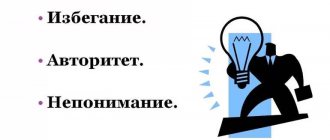What are the basic principles and approaches to increasing the motivation of employees in an organization? What methods are used to increase motivation? What are the mistakes when developing a motivation system?
Being a leader at the highest level is not easy. The production commander, who only gives out orders and fines, does not keep highly qualified specialists. How can you ensure that your subordinates receive moral satisfaction from their work and do not look towards competing companies?
We will consider motivation problems and their solutions in our new article. With you is the business magazine “HeatherBeaver” and regular author of publications Anna Medvedeva.
At the end of the article you will find an overview of mistakes that are made when developing and implementing motivation systems. Read and prevent management failures in your organization.
Content
- Concept of staff motivation
- Personnel motivation goals
- Theories of personnel motivation
- Maslow's theory
- McGregor's "X and Y" theory
- Herzberg Theory (Motivational-Hygiene)
- McClelland's theory
- Process theory of employee stimulation
- Vroom's Theory (Expectancy Theory)
- Adams theory
- Types of staff motivation
- Basic levels of staff motivation
- Systematic approach to personnel motivation
- Methods and examples of staff motivation
- Increasing the motivation of personnel in certain professions
- Non-standard methods of modern personnel motivation
- Professional assistance in motivating employees
- What will good employee motivation bring?
- Advice for beginning businessmen
- Conclusion
Even more ideas
Proper employee motivation should inspire the team. If you seriously decide to increase enthusiasm in your team, we advise you not to limit yourself to our advice and draw ideas from specialized literature:
- Radmilo Lukic “Material motivation of sellers. Principles, opportunities, limitations", 2010
- Svetlana Ivanova “100% motivation.” Where is his button?”, 2015.
- Klaus Kobiell "Motivation in the style of ACTION. Delight is contagious”, 2011
- Natalya Samukina “Effective staff motivation with minimal financial resources.” costs", 2006
- Elena Vetluzhskikh “Remuneration system. How to develop goals and KPIs", 2021
- Sarah Holliford, Steve Whiddett "Motivation", 2008
- Max Eggert "Motivation. What makes you do your best at work”, 2010
- Steve Chandler, Scott Richardson "100 Ways to Motivate", 2014
- Svetlana Ivanova “50 tips on non-material motivation”, 2021
- Reinhard Sprenger “Myths of Motivation”, 2004
Back to Contents
Concept of staff motivation
It is not often that you meet a person who is completely and completely satisfied with his job. This is because people often occupy positions not according to their calling. But it is within the power of the manager to make sure that the work process is comfortable for everyone, and that employees perform their duties with pleasure.
Successful businessmen know firsthand that their employees need to be stimulated and encouraged in every possible way, that is, motivated. Labor productivity, the quality of work performed, the company’s development prospects, etc. depend on this.
Motivation of personnel in an organization is activities aimed at the subconscious of a person, when he has a desire to work effectively and perform job duties efficiently.
For example, imagine a team where the boss does not care about his subordinates. It is important to him that the work is completed in full. If an employee fails to do something, he will be fined, receive a reprimand or other punishment. In such a team there will be an unhealthy atmosphere. All workers will work not by choice, but by force, in order to earn money.
Now let’s consider another option, where the employer motivates the staff in every possible way. In such an organization, all employees are likely to have friendly relations; they know what they are working for, are constantly developing, benefit the company and receive moral satisfaction from this.
A good manager simply must be able to stimulate staff. Everyone benefits from this, from ordinary employees to the highest management of the company.
Motivation: meaning and goals
Work motivation is understood as organizing the company’s work in such a way that everyone tries to perform their professional duties in the best possible way and “give their best.” In other words, each employee receives an internal incentive that increases productivity and is aimed at achieving a common goal.
Often, the company's administration acts in the old fashioned way: rewards the best, punishes the worst, and holds annual corporate parties for everyone. But this scheme does not always work. It is unlikely that you will want to go to a corporate event if the work environment is depressing every day.
Competently stimulating staff requires the manager to know basic motivation methods. A subordinate whose contribution to the overall achievement was not noticed or appreciated will not want to “prove himself” in the future.
Everyone needs praise: a newcomer who finds it difficult to “fit in” to the team, and a strict careerist who, under the dry mask of responsibility and devotion to the company, hides the desire to hear praise addressed to him or get additional leave.
The head of the organization develops his own individual motivation scheme for subordinate employees.
Motivation is the creation of internal factors that motivate you to do work. Motivation can be controlled from the outside, using stimulation techniques. Read more…
Personnel motivation goals
Motivation is carried out in order to unite the interests of the enterprise and the employee. That is, the company needs high-quality work, and the staff needs a decent salary.
But this is not the only goal pursued by employee incentives.
By motivating employees, managers strive to:
- Interest and attract valuable personnel;
- Minimize the number of people leaving (eliminate “staff turnover”);
- Identify and deservedly reward the best employees;
- Monitor payments.
Theories of personnel motivation
Many aspiring businessmen thinklessly approach solving motivation issues. But in order to achieve the desired results, it is not enough just to pay bonuses. It is necessary to analyze the problem and move on to its competent resolution.
To do this, it is necessary to study the theories of motivation of famous people. We will look at them now.
Maslow's theory
Abraham Maslow argued that in order to effectively motivate your employees, you need to study their needs.
He divided them into 5 categories:
- Physical needs are a person’s desire to satisfy his needs at a physiological level (drink, eat, relax, have a home, etc.).
- The need to be safe - all people strive to be confident in the future. It is important for them to feel physical and emotional safety.
- Social needs - every person wants to be part of society. He strives to have a family, friends, etc.
- Need for recognition and respect - people strive to be independent, recognized, have status and authority.
- The need to express oneself - a person always strives to conquer heights, develop as a person, and realize his capabilities.
The list of needs is compiled in such a way that the first item is the most important, and the last is less significant. A manager doesn't have to do everything 100%, but it is important to try to address every need.
McGregor's "X and Y" theory
Douglas McGregor's theory is based on the fact that people can be controlled in 2 ways.
Using Theory X, control is carried out through an authoritarian regime. It is assumed that the team of people is disorganized, people hate their work, shirk their duties in every possible way, and need strict control from management.
In this case, in order to improve work, it is necessary to constantly monitor employees, encourage them to conscientiously perform their job duties, and develop and implement a system of punishments.
Theory Y is radically different from the previous one. It is based on the fact that the team works with full dedication, all employees take a responsible approach to fulfilling their duties, people organize themselves, show interest in work, and strive to develop. Therefore, managing such employees requires a different, more loyal approach.
Herzberg Theory (Motivational-Hygiene)
This theory is based on the fact that doing work brings satisfaction or dissatisfaction to a person for various reasons.
An employee will be satisfied with his job if it contributes to his self-expression. Personnel development depends on the possibility of career growth, the emergence of a sense of responsibility, and recognition of employee achievements.
Personnel motivation factors that lead to dissatisfaction are associated with poor working conditions and shortcomings in the company's organizational process. This could be low wages, poor working conditions, an unhealthy atmosphere within the team, etc.
McClelland's theory
This theory is based on the fact that people's needs can be divided into 3 groups.
- The need for workers to manage and influence other people. People with this need can be divided into 2 groups. The first ones simply want to control others. The latter strive to solve group problems.
- The need to achieve success. People with this need strive to do their job better every time than the previous time. They like to work alone.
- The need to be involved in some process. These are employees who want recognition and respect. They love to work in organized groups.
Based on the needs of people, it is necessary to introduce the necessary incentive measures.
Process theory of employee stimulation
This theory is based on the fact that a person wants to achieve pleasure while avoiding pain. The manager, acting according to this theory, should reward employees more often and punish less often.
Vroom's Theory (Expectancy Theory)
According to Vroom, the peculiarities of personnel motivation lie in the fact that a person performs the work that, in his opinion, will satisfy his needs with the highest quality possible.
Adams theory
The meaning of this theory is as follows: human labor should be rewarded accordingly. If an employee is underpaid, then he works worse, and if he is overpaid, then he works at the same level. Work performed must be fairly compensated.
Economic (material) incentives
One of the most popular types of enhancing the performance of enterprise employees. A competent approach to remuneration increases labor productivity.
Economic motivation of personnel is divided into two subtypes: monetary and non-monetary.
Monetary incentives are:
- additional payments for high performance indicators: bonuses, bonuses, interest on transactions, salary increases;
- encouraging a healthy lifestyle. Bonuses for no sick leave, incentives for non-smokers, payment for gym memberships;
- payment of health and social insurance;
- increased pay for hazardous working conditions if they cannot be improved;
- provision, in addition to the annual leave provided for by the Labor Code, additional rest time (for family reasons, in connection with a wedding, study);
- cash payments for a birthday, wedding, anniversary, in emergency situations (death of loved ones, robbery, fire);
- compensation of employee expenses for travel to the enterprise or organization of official transport;
- pension benefits. Special compensation payments from the organization to reward deserving retired employees.
Non-monetary type of economic incentives:
- the presence of social institutions of the enterprise;
- free or partially paid vouchers for employees and their family members to sanatoriums or recreation centers;
- preferential terms for purchasing the organization's products;
- remuneration when changing jobs;
- improvement of working conditions and material and technical equipment;
- flexible schedule for performing professional duties;
- shortened working day or week;
- free tickets to concerts, theaters, cinemas;
Particular attention should be paid to the allocation of funds for corporate holidays. Carrying out such events helps to unite colleagues, instill a corporate spirit in the staff, and establish friendly relations between employees.
Types of staff motivation
There are many ways to motivate employees.
Depending on how you influence your subordinates, motivation can be:
Direct - when the employee knows that if the work is done quickly and efficiently, he will be additionally rewarded.
Direct motivation, in turn, is divided into:
- Material motivation of staff - when an employee is stimulated, bonuses, monetary rewards, vouchers to sanatoriums, etc.;
- Non-material motivation of personnel - when the work of employees is recognized by management, they are given certificates, memorable gifts, working conditions are improved, working hours are adjusted, etc.
Indirect - in the course of stimulating activities, the employee regains interest in work, he feels satisfaction after completing a task. In this case, employees have a stronger sense of responsibility, and management control becomes unnecessary.
Social – a person understands that he is part of a team and an integral part of the team. He is afraid of letting his colleagues down and does everything to complete the tasks assigned to him as efficiently as possible.
Psychological – a good and friendly atmosphere is created for the employee within the team and the company itself. A person should want to go to work, participating in the production process, he should receive psychological satisfaction.
Labor – stimulation methods aimed at human self-realization.
Career – when the motivation is to move up the career ladder.
Gender – an employee is motivated by the opportunity to brag about his successes to other people.
Educational – the desire to work arises when an employee wants to develop, learn something, and be educated.
In order for staff motivation methods to bring the desired result, it is necessary to use all types of employee incentives in combination.
Intangible
I have already mentioned more than once in my article that it is not only money that motivates well. Although you can’t go anywhere without them. It's a pity.
I myself could not use any other types of work motivation, but give out a lot of non-material motivation to my colleagues, if that alone were enough.
Therefore, we work comprehensively. Types of non-material motivation of personnel can be the following:
- Promotion. Both in the horizontal and vertical career ladder;
- Motivational speeches or meetings. They performed especially well during a crisis, when the morale of employees was falling;
- Motivational boards (easy to do if a CRM like Bitrix24 or Megaplan is implemented);
- Competitions and competitions;
- Cultural events within the company;
- Congratulations on significant dates for the employee;
- Public recognition of employee achievements;
- Peer ratings;
- Participation in meetings with management;
- Help with family matters.
Examples:
- I really like Zappos. It has a special department that helps employees solve ordinary, household, routine matters. For example, if you have a toothache, they can make an appointment with the dentist. Or take your mother to the hospital;
- At Google, department employees have a free lunch once a week, to which they can invite their loved ones;
- Also on Google for the best job in the client department, place a photo of a person with the caption “Best Employee of the Month”;
- At Lego, after 25 years of hard service, each employee is given a small gold bar shaped like a Lego piece;
- My favorite again is Zappos (in my opinion they have the coolest corporate culture). Once a month, your colleagues transfer the virtual dollars they have been given to the employee they like. All virtual money can be exchanged for very real ones.
By the way. If you decide to use CRM, then I recommend Megaplan, and especially for you - the “Megastart” promo code. It gives a 10% discount + another 14 days free -> megaplan.ru. Or test the most popular CRM in Russia – Bitrix 24.
This paragraph can be divided into two types: social and psychological. In order not to bother you, I deliberately combined all this into one.
I bet you didn’t even notice the difference in the examples given. If we summarize all this and call it in one phrase, we get “Make your colleagues HAPPY.”
Basic levels of staff motivation
All people are unique and individual. Some are careerists and the prospect of career growth is very important to them, while others prefer stability and lack of change. Based on these considerations, managers must understand that methods of stimulating employees must be selected individually for each employee.
There are 3 levels of motivation:
- Individual motivation - the employee’s work must be paid adequately. When calculating the amount of payments, the knowledge, skills and abilities that the employee possesses must be taken into account. It is important to make it clear to the subordinate that if he performs his duties well, he will receive a promotion.
- Team motivation is a group of people united by one thing and goal, working more efficiently. Each team member understands that the success of the entire team depends on the effectiveness of his work. When motivating a group of people, it is very important that the atmosphere within the team is friendly.
- Organizational motivation - the entire team of the enterprise needs to be united into one system. People must understand that their organization is a single mechanism and a positive result depends on the actions of everyone. This is one of the most difficult tasks for a leader.
Innovative methods of motivation
Methods of motivating staff are developed for a specific purpose: to stimulate improvement in the quality of work of subordinates. There are many innovative methods to improve performance. All of them can be divided into three main categories:
- Individual motivation is aimed at working with individual subordinates.
- Moral and psychological motivation is used to satisfy the basic internal needs of employees.
- Organizational motivation helps create a system of incentives for employees within an institution.
Individual
The implementation of individual methods of personnel motivation is possible in the following forms:
- Joint celebrations of significant events in the lives of colleagues: birthdays, weddings, anniversaries, assignment of a qualification rank, presentation of a certificate of commendation.
- Rotating appointment of a person responsible for organizing non-work events.
- Design of rooms for psychological relief and rest of personnel.
- Informing the team about the personal achievements of each employee. This can be done at general planning meetings, using honor boards or publishing a corporate newspaper.
- Conducting competitions with the presentation of symbolic awards. The spirit of competition is a great way to motivate subordinates.
Moral and psychological
Such motivation techniques contribute to the professional development of the employee and increase his performance. These include:
- Social diagnostics of company personnel. Diagnostics helps to identify the basic social problems of workers, solving which can be influenced by personnel.
- Conducting trainings and competitions aimed at identifying people with leadership qualities.
- Creating a special atmosphere. This includes the color scheme of office decoration, music in relaxation rooms and the opportunity to express creativity in everyday work.
The following is used as moral encouragement:
- praising an employee in the presence of colleagues;
- personal gratitude from the manager, expressed orally or in the form of a letter.
Organizational
The use of such motivation techniques allows us to systematize the work of the institution. The group of organizational incentives includes:
- Organizing meetings and planning sessions for the entire team. Informing subordinates about the company's objectives and the opportunity to hear everyone's opinions contribute to the involvement of all employees in the process of achieving a common goal.
- Administration. Includes:
- drawing up a list of functional responsibilities of subordinates;
- studying the regulatory framework related to the functioning of the institution;
- creation of a code of ethics for company employees;
- culture of communication with clients and colleagues;
- the formation of a system of rewards and punishments that applies to all personnel of the company.
Such techniques are popular in institutions where most employees have to be forced to work, and management is inclined to use “carrots and sticks.” On the other hand, a clear knowledge of one’s responsibilities, as well as the consequences of failure to fulfill them, is an important component of the work of every enterprise.
- Grading is one of the modern methods of increasing staff performance. This method of motivating staff makes it possible to form a hierarchical “ladder” of employees regarding their value to the company, on the basis of which the remuneration system for the work of each employee is calculated. Evaluation criteria used in grading: qualifications, education, responsibility, diligence, productivity.
Systematic approach to personnel motivation
In order to competently carry out incentive activities, it is necessary to remember that motivation is a system consisting of 5 stages.
Stage 1. Identifying the problem of staff motivation.
In order to understand what kind of motivational activities to carry out, the manager needs to analyze the motivation of the staff. To do this, you need to conduct a survey (it can be anonymous) and identify what your subordinates are dissatisfied with.
Stage 2. Implementation of management, taking into account data from the analysis of motivation and its goals.
When motivating employees, management must work closely with staff. Based on the research data, implement those methods that will bring benefits specifically to your enterprise.
For example , if the majority of employees are not satisfied with the length of the working day at the enterprise, then changes need to be made in this direction.
Stage 3. Influence on employee behavior.
When carrying out activities to motivate staff, it is necessary to monitor changes in employee behavior.
Employees will change it if:
- Management will accept constructive criticism;
- Reward employees in a timely manner;
- Demonstrate correct behavior by example;
- They will be taught the required behavior.
Stage 4. Improving the staff motivation system.
At this stage, it is necessary to introduce non-material methods of stimulating employees. Workers need to be convinced of the need to increase their productivity. The manager must “ignite” the subordinate and find an individual approach to each.
Stage 5. A well-deserved reward.
The company should develop a system of bonuses and incentives. When employees see that their efforts are rewarded, they begin to work better and more productively.
How to motivate yourself: methods, methods, techniques
For easy searching, all motivation techniques are sorted into sections. To quickly jump to the desired section, use the table of contents at the beginning of the page.
The most popular methods
Here are collected the methods of motivation that people use most often (sometimes even intuitively) and which are most often mentioned in books and articles on this topic.
1. Give yourself a reward for completing the task. This could be a purchase that you have been putting off for a long time, your favorite TV series, book, computer game or something especially tasty. Don’t use other people’s solutions: find something that will be pleasant for you.
2. Collect motivational materials. Create a separate folder on your computer or smartphone and put in it everything that inspires you and makes you want to act. These could be movies, videos, books, podcasts, articles, or even pictures. If your motivation drops, just look in this folder.
Example of a folder with motivational materials
3. Compile your own collection of inspirational quotes. Write down the quotes you like in a separate notebook or text file and refer to them in difficult times.
An excerpt from a personal collection of inspirational quotes
4. Read stories of other people's successes. If you, for example, are on a diet, look at photos of people who were able to effectively lose weight. If you want to start your own business, read about those who managed to build their business from scratch. Stories like this inspire and help you believe in yourself.
5. Try to make your tasks as interesting as possible. For example, if you are learning English, then read those books that you would be happy to read in Russian.
6. Choose inspirational music. Choosing the right compositions is the easiest way to create the right mood to complete a task. The method is especially relevant for physical labor and sports.
7. Create an interesting background. If you are engaged in “mindless” physical labor (washing windows, driving a car, planting potatoes), come up with parallel entertainment.
For example, try listening to music, podcasts, audiobooks, various courses and webinars while doing your work. And if your work does not require visual control, you can watch movies or videos.
Methods for quick self-motivation
This section contains techniques that help virtually instantly create motivation at the right time. They do not require any special equipment, so they can be used in any situation.
1. Technique of conscious choice. Ask yourself three questions:
- What choice do I have now?
- What will the choice of one option or another lead to?
- What do I choose?
For example:
“I have a choice: to smoke or not.” If I abstain from cigarettes now, then over time I will be able to get rid of the addiction. If I smoke, I will undo a whole week of my efforts and stop respecting myself. I choose: not to smoke.
Methods and examples of staff motivation
There are many ways to motivate employees. But before you put them into practice, think about which incentive methods are suitable specifically for your production.
We have compiled the TOP 20 best methods of motivation, from which each manager will choose a method that is suitable specifically for his production.
- Salary . This is a powerful motivator that forces an employee to do his job well. If wages are low, it is unlikely that this will inspire workers to devote 100% to the production process.
- Praise . Every person who conscientiously performs his work is pleased to hear that his work did not go unnoticed. The manager needs to periodically analyze the work of employees and not neglect praise. Using this method, you don’t spend a penny, but increase your productivity significantly.
- Address employees by name . For the authority of the director of the company, it is very important to learn the names of all employees. By addressing a person by name, a leader shows his respect for his subordinate. The employee understands that he is not just a faceless secretary or cleaning lady, but a person who is valued.
- Additional rest . Some enterprises encourage workers to do their work faster and better by offering additional rest. For example, an employee who showed the best result at the end of the week may leave work several hours earlier on Friday. Thus, passion and zeal to be a winner awakens in the team.
- Awarding with memorable gifts . On the occasion of any memorable dates, you can present your employees with memorable gifts. These may be trinkets, but if you engrave it, then the employee will probably show off such a sign of attention to his friends for the rest of his life.
- Prospect for promotion . All employees must understand that for quality performance of their work, they will receive a promotion. The prospect of moving up the career ladder is as motivating as material rewards.
- The opportunity to express your opinion and be heard . In any team, it is important to give all employees the opportunity to express their opinions. But it’s not enough to just listen; management must also listen to the advice and wishes of its employees. This way, employees will understand that their opinions are taken into account and listened to.
- The opportunity for each employee to personally communicate with the company's management . All managers, first of all, must understand that they are the same people as their subordinates. Directors only organize the production process, and the execution of work depends on their subordinates. Therefore, it is regularly necessary to organize personal meetings with employees, where important issues on a variety of topics can be raised.
- Hall of Fame . This is an intangible method of motivation that greatly increases productivity. To implement it, it is necessary to create an honor board where portraits of the best employees will be posted. Thus, production competitions are created that stimulate workers to improve their production performance.
- Provide the opportunity to do your work from home . This method is only suitable for individual companies. If an office employee has routine work that he can do without leaving home, he can be asked not to come to his workplace on certain days. But the main condition will be high-quality performance of job duties.
- Nice job title . Each profession and position is good in its own way. But if a nurse in a medical institution is designated as a junior nurse, then the person will not be ashamed to say who he works for.
- Corporate events . Many enterprises organize parties on the occasion of major holidays. At these celebrations, people communicate in an informal setting, relax, and make new acquaintances. Corporate events help distract employees and demonstrate the company's care for them.
- Public thanks . You can praise an employee not only personally. It's best to do this publicly. This idea can be implemented in several ways. For example, announcing the best employee on the radio, through the media or public address system at the enterprise. This will encourage others to do better so that everyone knows about their results.
- Providing discounts . If a company produces a product or provides services, then a discount can be provided for employees of this company.
- Accrual of bonuses . Material incentives are an effective method of motivating staff. Employees need to set a goal, upon reaching which they will receive certain additional payments to the basic salary in the form of bonuses.
- Motivational board . A simple but effective method of motivating employees. To implement the idea, it is enough to draw a graph of the productivity of each participant in the production process on the demonstration board. Employees will see who performs better and will strive to become a leader.
- Training at company expense . It is important for many employees to improve and improve their skills. By sending employees to seminars, conferences, trainings, etc., the manager shows his interest in the professional growth of his subordinate.
- Payment for a subscription to a sports club . From time to time, teams can organize production competitions, at the end of which the best employee will receive a subscription to a fitness club.
- Coverage of transportation costs, payment for communication services . Large companies often motivate their employees by paying for their transportation costs or cell phone service.
- Creating a bank of ideas . At an enterprise, you can create a bank of ideas in the form of an electronic mailbox. Anyone can send letters to it with their suggestions. Thanks to this, each employee will feel important.
How to increase employee motivation - 7 simple tips
The employee motivation system is diverse and largely depends on the specifics of the enterprise.
We have chosen universal tools and principles that will be useful to any leader and will come in handy in any team.
Tip 1. Ask employees about their performance
This does not mean total control over the activities of each employee. Of course, there is some degree of control here, but the main goal is different. This technique is necessary primarily for the internal composure of employees.
Not everyone will count at the end of the working day, for example, the number of calls made and how many of them were successful. If the manager begins to be interested in this, the employee’s level of self-information will increase, as will internal motivation after a visual analysis of his own achievements.
This topic will be complemented by information from the article “Staff Motivation.”
Tip 2. Strengthen interaction with subordinates
This is necessary to track the degree of interest of your employees in the results of their work. The majority of managers have a vague idea of the level of motivation in their team or do not have it at all. This gap is filled by ordinary communication with the team.
At pre-planned meetings, discuss not only work issues and plans for the future. Try to delve into what is important to employees now, what motivates everyone, and what hinders progress.
During detailed conversations, employees are convinced that management is interested in the lives of their subordinates, and the manager receives important information about the motivation of his employees.
Tip 3. Formulate instructions to employees as clearly as possible
The same applies to the reward system. The more specific the request is formulated, the more specific the results will be.
Every employee needs to know:
- what he does;
- why is he doing this;
- within what period of time he must do this;
- what will he get for it?
Largely thanks to specifics, the employee motivation system becomes successful.
Tip 4. Create an idea bank
The staff themselves will help you with this. Many of them develop interesting and useful thoughts during their working life, which are sometimes useful to put into practice. The main thing is to be able to listen and find a rational grain even in the most unusual and, at first glance, unpromising ideas.
To create a bank of ideas, keep a separate notebook or file (whichever is more convenient for you) and record all your employees’ ideas in it. Do this, and you will see that most of your colleagues have an extraordinary mind and imagination, and many have a sense of humor.
Tip 5. Motivate with knowledge
Any employee who is committed to career growth also strives to learn. A person who finds himself in his place acquires new skills in his professional field with interest and pleasure. Therefore, motivation by knowledge is a very powerful lever for self-improvement.
Let's add a small nuance. Provide the opportunity to acquire new knowledge that will be useful to employees in your production. Otherwise, you can prepare a specialist for someone else.
Continuing this topic, read another article on our website, “Types of staff motivation.”
Tip 6. Provide employees with unscheduled rest
There are many variations of this type of encouragement. For certain achievements, employees receive additional rest in the form of time off or, for example, the opportunity to come to work later on certain days or leave a little earlier.
Example
The office supply company introduced a record of goods sold during the week. A sales report is made every Friday evening.
Based on the results of the report, the most active sales manager is calculated. As a bonus for success, he receives the right to go to work on the coming Monday not in the morning, but in the afternoon.
This type of employee motivation is very important, for example, for young professionals.
Tip 7. Encourage employees financially
We have already talked about monetary rewards above. Here it is worth mentioning separately about the calculation of annual bonuses. Such bonuses are very important for every employee, and this is natural. After all, a long reporting period is closing, and the rewards for it are the highest.
Example
How can you calculate the bonus percentage relative to the amount of work completed?
If the set goals were achieved by 90% or more, the bonus is awarded in the amount of 100%.
80% of goals achieved - 50% bonus.
Less than 70% - no bonus is awarded.
Increasing the motivation of personnel in certain professions
When developing motivational measures, it is important to take into account the profession of workers and the type of employment.
Let's look at an example of motivating workers in some professions:
| Profession | Motivation methods |
| Marketer | Provide the opportunity to make decisions independently; Pay a bonus (a certain percentage of sales) |
| Manager | Organize production competitions with other managers; Give bonuses depending on sales volumes; Link wages to company profits |
| Logistician | For people in this profession, wages most often consist of a salary and a bonus. Moreover, the salary is 30%, and 70% are bonuses. They can be motivated by the size of bonuses. If their work did not cause failures, then the bonus is paid in full |
Non-standard methods of modern personnel motivation
In the Russian Federation, non-standard methods of stimulating labor are rarely used. But nevertheless they bring good results.
Not long ago, a survey was conducted in which office workers from different parts of Russia took part. They answered questions: what bonuses they would be happy with and what they want to see in the workplace.
Most people preferred:
- Office kitchen;
- A machine where everyone can make their own coffee for free;
- Soul;
- Recreation room, bedroom, smoking room;
- Exercise machines;
- Massage chair;
- Tennis table;
- Cinema hall;
- Scooters.
The fair sex preferred massage chairs and gyms, while the stronger sex preferred entertainment (tennis table, scooters, etc.).
what employees need
If you ask any person, especially a manager from the 90s, what is the essence and types of employee motivation, the answer will be more or less predictable - increasing productivity using “carrots and sticks”.
The stick usually means fines (standard 300-1000 rubles for an offense), while the carrot means bonuses or premiums.
But few people know that the level of motivation in an enterprise can be influenced by completely unusual things. For example, having a kitchen in the office where employees can have a snack, or just a standing machine with free coffee. These are small and small changes that can improve employee performance.
If you like to do everything to the maximum, then pay attention to the survey conducted by one Russian recruiting company.
According to the survey, 40% of respondents believe that the presence of a gym will increase the efficiency of their work in this company. But 37% were in favor of a massage chair, but most of them were women.
Based on surveys, we can conclude that the presence of such implicit items as a break room, a comfortable chair and other small components of work life have a positive effect on work in the company.
Proof of this is that 65% of respondents said they would spend more time at work if the company provided its offices with additional amenities. And you say that money is the main thing for them.
What will good employee motivation bring?
If a manager properly stimulates his employees, then within a few weeks a positive result will be noticeable.
Namely:
- Employees begin to take a more responsible approach to performing their job duties;
- The quality and productivity of labor increases;
- Production indicators are improving;
- Employees develop a team spirit;
- Personnel turnover is reduced;
- The company begins to develop rapidly, etc.
Advice for beginning businessmen
If you are a new entrepreneur, you must properly motivate your employees:
- First, always encourage your subordinates to get the job done;
- Second, ensure that employees' basic needs are met;
- Thirdly, create comfortable working conditions;
- Fourth, be loyal to your employees.
In addition, use the following tips:
- Take an interest in the lives of your subordinates, ask about their needs;
- Do not scold employees with or without reason. Better help them do the work that the employee can’t handle. After all, the failures of employees are the failures of managers;
- Do analysis periodically. Conduct surveys, questionnaires, compile work diaries and internal reporting;
- Pay unscheduled bonuses and incentives.
How not to motivate employees to work - 3 big mistakes
1. Scold in front of everyone;
2. Praise one on one;
3. Not informing employees about career moves, for what and why (for what services) the employee received such an important assessment. About the results of the competition. About “wishes” to the manager in envelopes.
In a word, silence here is absolutely the opposite of gold! Information comes first on all points of motivation. Word of mouth is good, but sometimes it works very slowly.
And I’ll motivate you, the leaders, a little...











